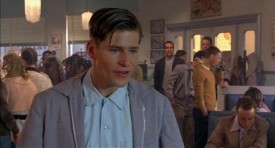
At the risk of sounding like a Media Studies teacher, I’d like to talk a bit about the themes of Stop/Eject. Warning: this post contains spoilers.
I see themes as a way of making a film seem tighter and more cohesive. Let’s say you have a scene where a character is reading a book. As a writer, you ask yourself what book he should be reading. Firstly you’ll probably consider the plot: is it important to the storyline what book he’s reading? If not then you’ll consider the character (which you should always do anyway of course): what kind of book would this character be reading? This will doubtless narrow down the field but ideally you should now think about the themes. Can he be reading a book which somehow reflects the themes? For example, if the film has an environmental theme, could he be reading Watership Down?
I used to see putting themes into a film as giving myself extra work, but it actually makes it easier to reach decisions because it narrows down your options. And anyone who knows me knows I need all the help I can get with making decisions.
Okay, onto Stop/Eject. The first draft script had no themes at all that I was aware of. When I had to give my characters something to do while talking I chose things at random and kept them pretty generic. But the thing about themes is they’re always there – you just have to find them and tease them out.

I chose a tape recorder as the vehicle for time travel in the film simply because it seemed like a cool idea. And I chose “hit by a car while trying to get mobile reception” for Dan’s demise just because I’m a grumpy old luddite who hates mobiles and I’ll take any chance I can get to portray them in a negative light. But then someone pointed out the link between these two things: audio.
So I chose to develop sound as a theme in subsequent drafts. How do you develop a theme? Easy. You just bung in more references to it.
So Dan’s hitherto-unspecified job became Sound Designer. Which in turn transformed an unoriginal scene of Kate working late to Dan’s chagrin to a more unique and thematic one in which Dan’s loud editing of some dialogue in his living room studio sparks the conflict.
Co-writer Tommy Draper and I had been struggling to come up with a satisfying “meet cute” (Hollywood parlance for the key scene in a romcom where the couple first meet). Dan’s new job soon provided the answer as we came up with a nice sequence in which Kate first sees him hovering around the weir with a big fluffy microphone recording sound effects.
We even tweaked little things to enhance the theme. So instead of Kate being woken up one morning by a beam of sunlight coming through a crack in the curtains, it’s an alarm clock: sound again. And instead of the driver who runs Dan over being distracted by writing a text, it’s tuning the radio that takes his eyes off the road.
Stop/Eject‘s other theme is destiny, as Kate quickly discovers that although she can effectively travel back in time she can’t change anything. This came in handy when trying to write Dan’s proposal speech; at the risk of it being too “on the nose” I had him tell Kate that she’s his destiny. (It doesn’t hurt that a certain George McFly may have uttered similar words.)

But the destiny theme is mainly developed visually. I picked the Derbyshire town of Belper to shoot in primarily for its aesthetic qualities, but as the script evolved I saw the thematic benefit of using Belper’s river wherever possible. A river flows continually, like time moving unstoppably forward… or like the tape in a cassette… which linked to another visual theme that had emerged: circles.
It was clear from early on that the film would feature many close-ups of the tape recorder, particularly the capstans (the bits that make the cassette spools go round). When storyboarding, I looked for places that I could echo this image to create a visual motif. The most obvious thing was to include a shot of a waterwheel in one of the river scenes. More subtly, I moved a scene to a bandstand so I could have Kate cycle around it. And when she microwaves a ready meal I conceived a shot looking straight down on it, inside the microwave, as it rotates. Aside from a visual continuity, hopefully these things will suggest the Circle of Life to viewers on some unconscious level – linking in to the destiny theme.
If you had told me in my A level Media Studies lessons, as Mr Clutterbuck paused Psycho for the twentieth time and pointed out some minor detail which I was convinced the director had not planned as deliberately as my teacher seemed to think he had, that I would one day put so much stock in cinematic themes I wouldn’t have believed you. But if you can take control of your film’s subtext I’m now convinced your audience will have a better time, even if they can’t put their finger on why.
If you’ve enjoyed this blog post and you’d like to see Stop/Eject get made, please contribute a few pennies at http://tinyurl.com/stopeject